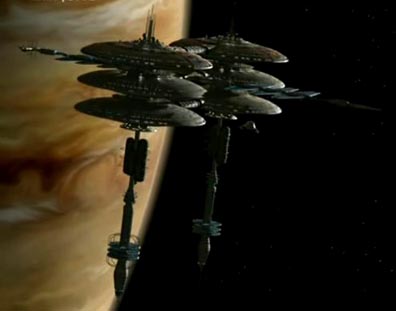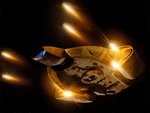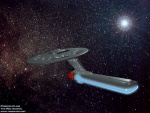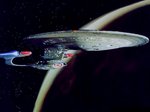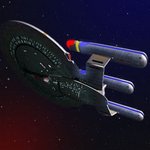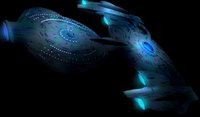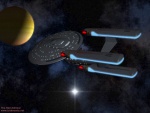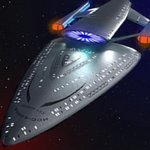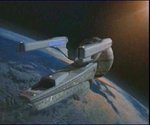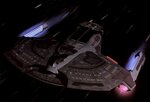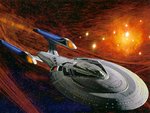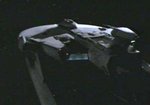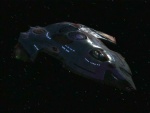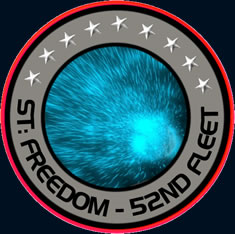Federation Starships
With the exception of the Indefatiguable, the Keltoi , the Meredith, the The Rosenanté and the Spectre class, most of the starship specifications linked to below were originally created for the online RPG Star Trek: A Call to Duty. To see the original version, as well as specifications for other starships, please visit their website here[1]
Federation Starship Classes and Technical Readouts
Akira Class
The Akira-class was in service with Starfleet by the early 2370s. Utopia Planitia Fleet Yards was one of the sites this class was constructed at in 2371. Akira-class starships were featured prominently in the Battle of Sector 001 and the Dominion War. Several Akira-class ships were stationed near Deep Space 9 during the war. As well, several were involved in most of the major battles of the war. In 2374, they saw action during Operation Return and the First Battle of Chin'toka, where at least one ship of the class was destroyed by an orbital weapon platform. In 2375, they were involved in the Second Battle of Chin'toka and the Battle of Cardassia.
New vessels off the line sport a forty attack craft in its through deck hangar as well as fifteen torpedo tubes, making the Akira Class the most lethal fighting vessel ever to serve in the Federation, more so than even the Prometheus Class Tactical Assault Cruiser and the new Defiant Class Escort vessels. Fast, maneuverable, and sturdy, sixteen of these ships alone were lost to the Dominion War. Presently, one hundred and five are serving throughout Federation Space, and no end is presently scheduled in the production life of the Akira Class.
Ambassador Class
The Ambassador Class series began construction in 2315, fifteen years before the Excelsior Class contract expired. They were originally intended to replace the Excelsior as the foremost Explorer Type vessel. Forty two vessels were built as Explorers, including the flagship USS Enterprise-C. However, when the First Cardassian War broke out in 2347, the Class was reclassified as a Heavy Cruiser, equipped with additional tactical systems, and structurally upgraded to counter the Cardassian Threat with eighteen ships built to the new specifications. At the end of the recent Dominion War, forty-nine Ambassador Class starships are still on operational status.
In 2344, the Enterprise responded to a distress call from the Klingon outpost on Narendra III, which was under attack by the Romulans. When the Enterprise arrived at the outpost, she was engaged by four Romulan Warbirds. Few details are known about the actual battle. What is known, however, is that the Enterprise was destroyed with the presumed loss of all hands.
In the aftermath of the battle, the Klingons were deeply impressed by the act of self-sacrifice by a Starfleet crew to protect a Klingon outpost, and the Enterprise-C's ultimate legacy was reinforcing the relations between the Klingon Empire and the United Federation of Planets, leading to a close alliance of peace.
It was later revealed by Sela (Tasha Yar's Daughter) that the Romulans took a number of the ship's crew prisoner. It was also learned, that during the battle, the Enterprise was transported to 2366, twenty-two years into the future, by a temporal rift. The disappearance of the Enterprise from the battle into the rift was said to have created an alternate timeline. In this alternate timeline, the outpost at Narendra III had been completely destroyed, and a state of war existed between the Klingon Empire and the Federation.
Sela's account of events, learned from Tasha and explained to Captain Picard were this; The Enterprise-C emerged from the rift in 2366, the Enterprise encountered the USS Enterprise-D. The Enterprise-C had depleted their weapons systems, suffered severe damage to her warp nacelles and external hull, with 125 crew members surviving, and the Enterprise-D assisted in repairs. Both ships soon came under attack from the Klingons, and Captain Garrett was subsequently killed. The last surviving senior officer of the Enterprise-C, Lt. Richard Castillo, assumed command of the ship and, under the cover of the Enterprise-D, took her, with one crew member from the Enterprise-D, Tasha Yar at tactical, back into the rift to return to 2344 and the battle of Narendra III to restore the timeline.
Sela also stated that, during this alternate time line, Lieutenant Natasha Yar had not died and was still the tactical officer for the USS Enterprise-D. As a result of a consultation with Guinan, she learned of her own death and requested a transfer to the Enterprise-C. She returned to the past and was subsequently captured by the Romulan forces. She later gave birth to a half Romulan daughter named Sela.
Natasha Yars temporal incursion resulted in an ontological paradox wherein Sela later captured Captain Picard on a mission to Romulus.
Constellation Class
The Constellation class was fielded during the 2280's as a modern counterpart to the Constitution class. Like the Constitution Class, the Constellation's requirements, issued in 2272, called for a vessel capable of long duration exploratory, scientific and diplomatic missions. The new ship was to be able to perform this role over the longer ranges called for now that the Federation had acquired new members beyond its previous borders. In addition, the Constellations combat capability was to put it ahead of any current or projected vessels in the Romulan and Klingon Empires.
The Constellation's configuration marked a substantial change in Starfleet design practice of the time. During the era, Starfleet had experienced significant problems generating and controlling the large scale structural integrity fields required for heavy cruiser class ships. The solution adopted was to build smaller vessels within one single hull unit, while larger vessels required two hull units fitted with independent SIF's
The Constitution class is a classic example of this philosophy. With the Constellation it was thought that SIF technology had advanced to the point where a Heavy Cruiser class could be fielded within a single hull. This would allow much duplication to be avoided, freeing up space for extra equipment and improving the efficiency of the design. In addition to their unusual hulls, the Constellations employed four warp nacelles instead of the usual two, the first Federation starship to try this variation. It was thought that this would give the Constellation class a significant increase in speed and maneuverability across the warp flight envelope and improve the fuel efficiency at medium cruise speeds by some 15%.
In retrospect, it can be seen that the Constellation designers attempted to accomplish too much in one step. Severe problems were encountered with the development of the new warp core and several vessels experienced a variety of failures with this system.
After a great deal of time and effort it was decided that the warp core of the Constellation class was simply not up to the job of producing the power required. It was learned that the more nacelles required more power, in spite of the speed and acceleration advantages. Starfleet was denied the resources required producing a new design and refitting the fleet, so instead a "stopgap" option was chosen, the power output of these ships was restricted by limiter software in the engineering systems.
Unfortunately while it solved the near constant emergencies, this measure also robbed the Constellation class of some of their most important advances. They were seriously under powered for their size, a factor which adversely affected almost every aspect of their operation. Despite this Starfleet was committed to the production of these ships on a large scale and despite the problems it went ahead as scheduled, and forty-six Constellation class ships were ordered, which was later boosted to an even fifty.
Over the years many attempts were made to rectify the problems with the Constellation class, and eventually some success was achieved. Between 2300 and 2310 six units received a new upgraded warp core which brought them close to their original designed power output. Other units of the fleet received new control software which allowed their power to be safely boosted by some 15% on average. However, by this time the class was some twenty years old and had fallen well behind the leading edge of technology. It was decided that an extensive refit of the Constellations would not be an efficient use of resources, so most of these ships were forced to soldier on with their various problems.
With the advent of newer designs in the 2330's some of these vessels were retired altogether, while others were assigned border patrol duties. In the 2370s, the eighteen remaining in service were finally upgraded, giving them the power they needed. While the class is nearing its 100 birthday, this upgrade has assured that the remaining ships will be active and useful for at least another decade.
The Constellations have had a generally undistinguished career, with some notable exceptions, one being the USS Stargazer. The first vessel commanded by Captain Jean Luc Picard, the Stargazer was the first vessel in Starfleet to perform the "Picard Maneuver" which it used to destroy an attacking craft now known to be a Ferengi Marauder. The Stargazer was heavily damaged in the engagement and was abandoned and believed destroyed. In 2364 the ship was recovered and now resides in the Fleet Museum.
A few Constellation class vessels remain in service today.
Constitution Class
In 2269, the USS Enterprise was selected to be the first ship to undergo such a refit and went into spacedock in Earth orbit for eighteen months of work. Never in Starfleet history (up until that time) had any vessel been so comprehensively updated, essentially a new vessel was built onto the bones of the old, replacing virtually every major system. The Enterprise was rushed out of Spacedock in 2271 to face the threat presented by the entity known as V'Ger, which was destroying everything in its path as it advanced towards Earth. She succeeded in averting the danger and then proceeded with her shakedown cruise.
Once the Enterprise was through with her shakedown cruise, the remaining Constitutions where refitted in quick succession and the Miranda and Akula class ships in service were readied for similar refits. The new ships proved to be more than capable of carrying out their normal exploratory and scientific roles, while in the combat arena they where judged an easy match for the refit Klingon K'T'Inga class.
The Constitutions continued in service, and once again the Enterprise set the standard for the rest of the ships to follow. After her shakedown the ship conducted another five year exploratory mission under Admiral Kirk before being transferred to training duties in 2277 under Captain Spock. She continued in this role for a further eight years, and many of Starfleet’s most successful officers went into space for the first time aboard this ship.
In 2285 the Enterprise suffered heavy battle damage while preventing Khan from stealing the Genesis Device, the ship was to be retired at this point, but Kirk and his officers stole her and took her to Genesis to retrieve Captain Spock's regenerated body from the planet. The Enterprise was attacked and crippled by a Klingon Bird of Prey while at Genesis, and was subsequently destroyed by Admiral Kirk shortly after the Klingon crew boarded to take control.
The USS Yorktown, NCC-1717, was subsequently renamed as the second Starship Enterprise, NCC-1701-A, and assigned to the Captain Kirk. The Yorktown had recently emerged from a major refit and repair following it's encounter with 'the whale probe', and the ship suffered many technical problems, nevertheless, she went on to serve the remainder of her service life with distinction.
In it’s most notable mission the Enterprise-A and the USS Excelsior participated in at the Khitomer conference, as the Enterprise escorted the Klingon Chancellor to the first meeting, assassins beamed over to the Klingon ship and killed the chancellor. Kirk and his chief medical officer where arrested and convicted of this crime, and sentenced to life imprisonment on the penal asteroid of Rura Pente; Kirk promptly escaped and took the Enterprise to the conference at Khitomer, preventing another assassination attempt and saving the peace process.
The Enterprise-A went into retirement shortly after this mission, and she's now a part of the Starfleet Museum. Most of the remaining Constitutions where decommissioned over the following twenty years, as the Excelsior class starships became available in larger numbers. The ten that remained in service received refits to their systems several times over the years to keep pace with current technology.
Two of the class were lost fighting the Borg, one at Wolf 359 and the other in Sector 001 a few years later. In 2335, four of the remaining eight Constitutions’ were mothballed while a second major refit of the class was designed. Of the other four, they were all active at the beginning of the Dominion war. Two are still in operation, including the class leader, the USS Constitution.
Defiant Class
The Defiant is a prototype vessel for the Defiant class warship, originally developed to counter the Borg threat. It is officially designated as an escort vessel to avoid the perception that Starfleet builds warships, as it is primarily a peacekeeping and exploration force. Following the Borg invasion, the United Federation of Planets approved a project committed to enhancing Starfleet's offensive and defensive military capabilities; the Defiant was the end result of that project. According to his statement in the episode "Defiant", Benjamin Sisko was in charge of the shipyard where the Defiant was built and helped design it during his assignment to the Utopia Planitia Fleet Yards.
Although it was designed to be fast and highly maneuverable with powerful weaponry, the Defiant was overgunned and overpowered for a vessel of its size. The ship's structural integrity field needed extensive modifications to keep the Defiant from tearing itself apart. The ship was designed specifically for battle, featuring innovative pulse phaser and quantum torpedo armaments, in addition to photon torpedoes, standard phasers and a high-capacity deflector shield system. Another asset is its ablative armor, enabling the ship to sustain multiple hits from enemy weapons even with the shields inoperable with minimal damage.
The subsiding Borg threat and failed systems tests (particularly in regard to the ship's overpowered engines) led the development project to be stalled and the prototype to be mothballed. Following work done at Deep Space Nine, the class would later go into production with at least a half dozen other ships in service by 2374 and onward.
Inside, the Defiant is relatively spartan by Starfleet standards of the time: the ship is not designed to carry family members, has no science labs or holodecks, and has a limited infirmary. Crew quarters consist of two bunk beds and a general computer interface. Individual quarters have food replicators, but the mess hall is a popular place for the crew to eat on missions.
The Defiant is the first Starfleet ship to legally carry a cloaking device. Supplied by the Romulan Star Empire, the cloak is initially operated by a Romulan officer serving aboard the Defiant. An agreement between Starfleet and the Romulans limits the use of the cloak to intelligence-gathering missions in the Gamma Quadrant in exchange for all of Starfleet's intelligence on the Dominion.
The USS Defiant remained at Deep Space nine under the command of Captain Benjamin Sisko, and Worf, to help with the Dominion incursion. In 2373 the Defiant was on on the verge of destruction by the Borg before the USS Enterprise-E arrived and lead the remaining Starfleet vessels in destroying the invading Borg cube. During the battle, the Defiant is under the command of Commander Worf and suffered severe, but repairable, damage.
In 2375, the Breen destroy the USS Defiant during the invasion of the Chin'toka system. The battle marks the first time the Breen use their energy-dampening weapon. During the planning of the invasion of Cardassia Prime some months later, a new Defiant class starship, the USS São Paulo (NCC-75633), is assigned to Deep Space Nine. The Starfleet Chief of Operations granted special dispensation to rename the ship Defiant.
Excelsior Class
The USS Excelsior, NX-2000 (Later changed to NCC-2000, Under Captin Sulu), was the first starship of her class and commissioned as a testbed for new technologies by Starfleet Command, hence the name the "Great Experiment". One of these technologies, transwarp drive, was seen as a possible revolution in starship design, with the potential to open up the entire galaxy to exploratory missions due to vastly increased speed. Sulu (who eventually becomes her Captain), marvels at the ship, however Montgomery Scott dismisses it as a "bucket of bolts". The transwarp drive failed on Excelsior's first mission (the pursuit of the hijacked USS Enterprise, during the Genesis Planet Incident) due to sabotage by Montgomery Scott, who was very briefly appointed chief engineer of the vessel, to his chagrin. The Excelsior Class is one of the most successful in the Federation, serving from 2287 to the present.
The basic Excelsior-class design includes a circular primary hull with a bridge at the center of the dorsal side, a sensor dome at the bottom of the ventral, and impulse engines at the aft end. The saucer is attached to a backward-angled neck extending downward from the aft of the ventral side to the secondary hull, which is roughly tubular with a flat platform on the dorsal side; the hull has a navigational deflector at the bow and a shuttlebay aft. Two warp nacelles are above the secondary hull, slightly above the primary hull, supported by pylons that attach to a bulge on the top of the secondary hull, run to the sides, and go upward from an angle (slightly more than 90°) to the nacelles. A semi-circular cargo bay lies at the bottom of the secondary hull.
The USS Enterprise-B, was an Excelsior-class refit vessel, a variant of the Excelsior model. This variant included two additional impulse engines running aft from the saucer section on both sides of the original impulse system, different warp nacelles, and an enlarged engineering hull along both sides of the deflector dish. The Excelsior class USS Lakota was also of this design.
Freedom Class
Classified as a destroyer the Freedom class starship was only moderately successful in her deployment. The vessel was one of the few federation designs that employed only a single Warp Nacelle. The vessel was used primarily for patrolling shipping lanes within the confines of the United Federation of Planets. During the Borg attack against the invasion at least one Freedom Class starship, the U.S.S. Firebrand, was involved at the battle of Wolf 359.
Max warp speed is Warp 9.2. It has seven Phaser Arrays, 3 Photon Torpedo Launchers (Stocks 175 torpedoes). Quantum Torpedo and propulsion upgrades in 2378.
The older types of this vessel were the Class I Destroyers, and Class I Scouts; based on the original Constitution Class, with the single warp nacelle in place of a Secondary hull.
Galaxy Class
One of the finest Starships ever designed the Galaxy class was to replace the Ambassador and Oberth-Class starships as the primary instrument of Federation exploration. The Galaxy-Class starship was the first to feature a saucer section which could separate at will and reattach itself without a starbase layover. The Galaxy-Class project was conducted at Utopia Planitia Shipyards, orbiting Mars.
Major component construction of Galaxy-class ships was carried out both in orbit and at ground based facilities.
The Galaxy-class contrasts with previous starships (specifically the Constitution class starship), however, in that the saucer section is considerably wider than it is long (instead of perfectly round); the nacelles pylons are roughly half the height of the ship's neck (instead of the same height); and the entire ship is designed with an emphasis on forward-leaning arcs (instead of a basic geometry of straight and parallel lines). This new design is to coincide with warp-field geometry, to make transition into warp drive not only faster, but more energy efficient, and to read higher speeds than any other starship in the fleet.
The design included two hull sections: a saucer-shaped primary hull, and a detachable secondary hull which housed the ship's primary engines. They could be reversibly separated, and were both equipped with independent flight and combat capabilities. Generally, civilians and non-essential personnel would evacuate to the saucer module, while the senior staff confronted a threat in the battle section, which contained the majority of weapons systems.
The hull of the Galaxy-class was left somewhat customizable; areas such as Deck 8 were designated as unfinished and multi-purpose, in the event that extra space was needed for a specific mission.
The warp core spans twelve decks in the engineering hull. The deuterium tanks are above the core, while antimatter storage pods surrounded the base of the core on Deck 42.
Upgrades to the propulsion systems were tested in 2370 aboard the Enterprise-D; the ship received a new warp core manufactured with interphase technology. A major overhaul of the nacelles was also conducted that year. By the mid 2370s, most Galaxy-class ships began operating with all three impulse engines activated.
The Galaxy-class was equipped with ten phaser banks, distributed in phaser arrays at various points along both hulls. One array was located on the dorsal of the battle section and could only be used following a separation. There were also fore and aft torpedo launchers on the engineering section. Each launch tube was capable of firing at least five photon torpedoes simultaneously, each torpedo capable of being independently targeted. In the 2360s, Galaxy-class ships typically carried about 250 photon torpedoes. The torpedo launchers were also capable of launching probes. The Galaxy-class also supported a high-capacity deflector shield grid. The Enterprise-D received weapons systems upgrades in 2370, including a loadout of higher-yield photon torpedoes and enhanced targeting sensors programmed by Lieutenant Worf. Certain Galaxy-class ships, such as the USS Venture, were refitted with additional phaser strips on the dorsal surfaces of their nacelles by 2372.
Galaxy Class Refit
In the year 2369, Starfleet charged Utopia Planitia Shipyards and Avalon Shipyards to design and/or modify a vessel with both strong exploratory and defensive powers while the Sovereign project was still under development. Avalon began design and construction of what would later be called the Keltoi class of vessels, whereas Utopia Planitia built off of the existing Galaxy class Star frame.
The result was the Galaxy Class "Dreadnaught," a refit version with an upgraded power source, one more warp nacelle for warp stability and serious upgrades to her weapons array. She has the same sensor capability as the standard Galaxy Class, but her weapons and defenses have nearly doubled in power and striking ability.
The aging Galaxy class ships were due to be retired as a ship of the line, but the Enterprise-D with its long service history was refitted with modern weaponry, defenses, and engines, at the behest of Admiral Riker. The Galaxy refit classes most prominent feature is the third nacelle on the secondary hull, this along with the improved engine designs allow the ship to reach speeds in excess of warp 13, or warp 9.993 on the mid 24th century scale. The Galaxy Refit class also features a heavy beam cannon on the underside of the saucer section, this cannon is capable of piercing enemy shields and hulls with one blast. Along with the main cannon, sixteen new phaser arrays have been installed on the ship. The class may also have other upgraded system though no information exists on them.
The Galaxy Class is fitted with three dorsal Phaser arrays on the primary hull, one primary dorsal array extending three hundred forty degrees and two point defense arrays to either side of Shuttlebay 1. The arrays cover the entire semi-sphere above the ship, except for a few blind spots close to the hull and Shuttlebay. There are also two Phaser strip arrays which give a total of three hundred and forty eight degree coverage.
There is also one ventral Phaser array and one Phaser Strip array on primary hull; the primary ventral array extends three hundred twenty degrees. The array covers the forward and lateral portions of the semi-sphere below the ship, except for those blind spots close to the hull.
Finally there is the Ventral Phaser Cannon, which provides the Galaxy Dreadnaught with tremendous hitting power. There are a total of six Phaser arrays as well as the cannon on the primary hull.
The Class also includes two dorsal Phaser arrays and a Phaser Strip array on the secondary hull, both are point defense arrays placed in the far aft of the ship. There are three ventral Phaser arrays; one primary array with coverage similar to a series of cones with the same vertex and two point defense arrays at the far aft of the ship. This gives the Galaxy Class a total of six Phaser arrays on the secondary hull.
Finally there is one lateral primary array on each vertical bound pylon. Coverage is similar to Secondary Hull's Ventral Primary array. This leaves a total of two Phaser arrays on the Nacelles.
The Galaxy Class has eleven Type-XII Phaser arrays and four Type XV multi-fire strip arrays. Each array fires a steady beam of Phaser energy and the forced-focus emitters discharge the Phasers at speeds approaching .986c. Current Tactical policy has Phaser arrays automatically rotate Phaser frequency and attempt to lock onto the frequency and phase of a threat vehicle's shields for shield penetration.
Each Phaser array takes its energy directly from the impulse drive and auxiliary fusion generators. Individually, each type-XII emitter can only discharge approximately 8 megawatts. However, several emitters (usually two) fire at once in the array during standard firing procedures, resulting in a discharge of approximately 16 megawatts.
The maximum effective range on the Type XII emitter is 300,000 kilometers.
The Galaxy Class Dreadnaught is armed with the Mark XXV photon torpedo and the Mark Q-II Quantum Torpedoes capable of pattern firing (sierra, etc.), spread firing, as well as independent launch. The Vessel is normally outfitted with both photon and quantum torpedoes capable of being fired from any launcher on the ship. Independent targeting once launched from the ship, detonation on contact unless otherwise directed.
Payload: The ship can carry a maximum of 600 torpedoes of either type. Range: Maximum effective range is 4,050,000 kilometers.
The Galaxy Class Dreadnaught is equipped with a Symmetrical subspace graviton field. This type of shield is fairly similar to those of most other Starships. Under Starfleet Directives all vessels now incorporate the nutation shift in frequency. During combat, the shield sends data on what type of weapon is being used on it, and what frequency and phase the weapon uses. Once this is analyzed by the tactical officer, the shield can be configured to have the same frequency as the incoming weapon - but different nutation. This tactic dramatically increases shield efficiency.
There are a total of eighteen shield generators on the Galaxy Class Dreadnaught. Each generator has a cluster of twelve thirty-two megawatt graviton polarity sources feeding a pair of six hundred twenty five millicochrane subspace field distortion amplifiers. During emergency situations the generators are synchronized together providing two thousand 688 megawatts continuously. The maximum peak load is seven hundred forty-three thousand megawatts for one hundred seventy milliseconds.
The shields, when raised, operate at two distances. One is a uniform distance from the hull, averaging about ten to twelve meters. The other is a bubble field, which varies in distance from any single point on the hull but has a common center within the ship.
Originally developed in 2367 during the Defiant Class Development Project, ablative armor is still considered to be a significant breakthrough in starship defense by effectively creating a beam-retardant layer that greatly increases a ship's life expectancy in battle. Originally deployed only on ships of the Defiant class, ablative armor showed remarkable dispersion properties against various beam-type energy weapons, including the various types of Phaser, disruptor, polaron, and focused-plasma beams employed by nearly all threat races. The armor works by first dispersing incoming beam energy across the hull of the ship where, after reaching an undisclosed threshold, causes part of the armor to boil away, taking with it a large fraction of that energy. The effect also creates a modest vapor cloud, which effectively disperses the incoming beam further, causing it to do less direct damage to the hull. It should be noted, however, that the armor is not a hull replacement, but a supplement and must be replaced over time due to the boiling away process.
Because of the tactical nature of the Galaxy Dreadnaught, Starfleet Command requested that the ablative armor be used to supplement the defenses of its new flagship class. Initially considered to supplement the majority of starship classes, production complications and long fabrication time makes the usage of the armor limited to warships and high-risk classes, resulting in only limited usage around vulnerable areas of standard Galaxy and Akira-class starships and almost-total body coverage of the Defiant, Galaxy Dreadnaught and Sovereign. Encounters with the Borg had already proven their ability to penetrate Federation shielding on, at that point, two occasions - the U.S.S. Enterprise-D's encounter at system J-25 and again at Wolf 359. It was then only natural that the redesign team saw the need to outfit the Galaxy Dreadnaught with this additional layer of defense should the Borg or other threat races find a means of penetrating the regenerative shielding.
Each Galaxy class Dreadnaught is equipped with an average depth of 10 centimeters of armor hull-wide, which can be replaced as wear permits at select fleet yards. Due to the supply demands, repairs made to the hull of a starship in the field will lack the extra layer of armor until the vessel is able to dock at a facility with spare plating.
Intrepid Class
The Intrepid Class Starship is designed primarily as a science/scout ship. This class is designed with variable geometry warp nacelles, to exceed Warp 5, while eliminating damage to subspace. Beginning with Voyager, the Intrepid line was the first to incorporate bio-neural technology into the computer systems. The storage medium is RNA-based, which allows the starship computers to accomplish computations almost at the speed of biological entities.
Intrepid-Class ships were also among to first to have and emergency medical holographic programs.
One of the few Starfleet starship classes capable of atmospheric entry and planetary landing, the Intrepid-class starship was equipped with antigravity generators as well as impulse and lifters strategically placed at the mass and stress points on the bottom portion of the secondary hull. Prior to and during landing or takeoff procedures, the vessel typically went to blue alert, indicating to the crew they were to assume their code-blue stations.
The class boasted the best navigational sensors, and the highest top speed of any Starfleet vessel until the development of the Prometheus-class. Its multi-mission design was backed up by a main computer processor capable of simultaneously accessing 47 million data channels and sustaining 575 trillion calculations per nanosecond in operational temperatures from 10 Kelvin to 1790 Kelvin.
The Intrepid-class utilized a ship-mounted phaser array system. The dorsal saucer section was covered by four phaser arrays, two of which extended from the aft curvature, along the length of the saucer and stop short of the auxiliary deflector incision. One smaller phaser array extended behind the bridge. The aft firing arc was covered by two smaller arrays, angled on the rear of the saucer section. The relative bottom of the ship was protected by two similar arrays as on the dorsal saucer section, extending to the rear of the saucer and following the curve to the auxiliary deflector incision. More protection was provided by an array that extended across the ventral engineering hull just fore of the warp core ejection port. Far-aft strips were provided on the underside of the variable-geometry nacelle pylons and under the shuttlebay landing deck on the underside of the ship for a total ship's complement of fourteen phaser arrays. Additional phaser banks included at least four separate phaser emitters, two in the aft torpedo launcher, one aft phaser bank located behind the second tractor beam emitter, in the aft section of deck 14, and an embedded emitter on the ventral surface of the ships right nacelle.
The Intrepid-class housed five standard torpedo launchers (two fore and two aft, and one on the dorsal side of the ship ). The USS Voyager was loaded with type-6 photon torpedoes in 2371. She also had at least four class-10 photon torpedo warheads and two tricobalt devices in her torpedo arsenal, as well as spatial charges. Cardassian quantum torpedoes were also compatible with Intrepid-class launchers, with some modification. The Intrepid-class' deflector shield was a symmetrical, oscillating subspace graviton field. During combat, the shield sent data on what type of weapon was being used on it and what frequency and phase the weapon used. Once the tactical officer analyzed these data, the shield could be configured to have the same frequency as the incoming weapon, but different nutation. This tactic dramatically increased shield efficiency. There were a total of fourteen shield grids on the Intrepid-class.
Each Intrepid-class tractor beam emitter was directly mounted to the primary members of the vessel's framework. The forward emitter was located on the underside of the secondary hull under the main deflector dish. The second emitter was located at the aft end of the secondary hull in the aft section of Deck 14.
The main impulse engines on an Intrepid-class starship were located on the aft end of the pylons leading to the warp nacelles. Intrepid-class starships were also equipped with auxiliary impulse reactors.
Main engineering is located on Deck 11. The room was constructed around the matter-antimatter reaction assembly class 9 (also known simply as the warp core class 9), featuring two levels. In front of the warp core was a large monitoring area on the lower engineering level. Also located on this level was the chief engineer's office and an open work area for special projects or situational analysis. A second tier ringed the upper level of main engineering. A small, single-person elevator, as well as a ladder on the opposite side, provided access to this catwalk.
Keltoi Class
The Keltoi Class starship entered service in 2403 and has quickly become the proposed tactical backbone of Starfleet’s next generation of starships. Keltoi Class Vessels are part of the growing ideal that the Federation and Starfleet require quick, fast ships that deliver a powerful punch and can survive heavy damage, while still being able to fulfill adequate scientific needs during patrol and peacetime.
The Keltoi class is renowned for its reliability in combat; she is a departure for Starfleet in her design and layout. The USS Keltoi, the prototype of the class, spent several months on the Cardassian border. In a mission to defend a Federation subspace relay, the Captain of the Keltoi, held for several days against several waves of Cardassian ships. Severely damaged in her efforts, the Keltoi was decommissioned, and shortly after, the Keltoi development project was approved.
Initial design and production of the Keltoi Class began at the Advanced Starship Design Bureau (ASDB), Utopia Planitia Shipyards, Mars, and her plans were finalized there after six years of intense R&D. Head of the Keltoi Class Development Team was Admiral Jopek. Some of her prefabricated hull plates were designed and made at the Fleet Yards of New Aberdeen and Antares, as overseen by various members of the Keltoi Class Development Team.
Unlike the design theory of the past one hundred years, the saucer section of the Keltoi Class cannot separate into a separate ship without first destroying the boom between the Stardrive and Saucer sections. Reattachment is only possible at a major Starbase or Dry-dock facility. As a result, the entire ship's structure has been radically strengthened to promote strength of spaceframe in theoretical Combat situations. This design, built along a long-axis rather then a split-hull of prior designs such as the Galaxy and Ambassador classes, allows for an easier entry and exit from subspace warp fields. Also as a result, the warp-fields of the ship can be refined to an even greater level of detail, allowing the Warp Drive to operate more efficiently and at higher speeds with such equipment as a Cloaking Device in operation. The design of the Keltoi class can be readily traced to her roots as a Defiant Class vessel, with the Warp Nacelles parallel to the hull and no major hull-pieces making a clear target. Her horizontal profile, therefore the amount of hull she offers in target to an enemy, is only 1/3rd that of an Ambassador Class ship, 1/2 that of a Sovereign Class ship, and 1/6th that of a Galaxy Class ship. Also do to this minimal profile; it is possible to configure both primary and secondary shields to provide full cover with more efficiency and less energy.
The armaments and final design of the weapons systems were finalized during the end of the primary development phase, and built into the systems during the first production of the test vehicle, the USS Keltoi, by the ASDB development team. As she was a battle-ship, designed for tactical operations, weapons and sufficient power were a primary concern during the development stage and many design changes were made by a Secondary development phaser over the first two years of construction. The result was powerful Type XII phaser strips in key locations over the hull that cover a full 100% of altitude and azimuth without maneuvers, two photon launchers fore and aft that cover 65% altitude and azimuth without guided torpedoes and maneuvering, and three quantum torpedo launchers situated two at the bow and one at the stern that cover 90% altitude and azimuth without guided torpedoes and maneuvering.
Heavily armed, the design philosophy for the Keltoi Class took it's lessons from the Enhanced Deterrence status of the Sovereign class, and most heavily from the maneuverability and low-profile of the Defiant Class. The idea that she would be a gunboat was rapidly scrapped, opting for less deck-storage space for torpedoes and more output power for enhancedpower phaser strips, with triple backups of all control and power systems to ensure their continued functionality during combat. In terms of raw phaser and torpedo power, the Keltoi Class can easily match the much vaunted Sovereign Class, with her maneuverability and increased size she provides a nice step-up in firepower and flexibility from the smaller Defiant Class.
With the design and production of the Sovereign, Galaxy and Nebula class, it was deemed a waste of effort to devote the same amount of space to sensors as the typical explorer, opting rather for an enhanced Tactical Sensor package and state-ofthe-art Guidance programs. The Keltoi Class carries a minimum standard scientific package for those times the ship is on a standard non-defensive patrol, and can fulfill the duty adequately in the absence of a fully staffed and geared Science or Exploration Vessel. The Keltoi Class's primary duties, however, are to stand on patrol in sensitive areas where combat is possible, or likely. Keltoi Class ships are also outfitted with full facilities for a Marine Company, including weapons storage and enough shuttlebay space to hold a small compliment of Marine landing shuttles, in addition to a minimal/standard compliment of shuttles and work-craft. Her weaponry, defenses and maneuverability enable her to stand face-to-face with New Generation battle-craft by any known sector power; with plenty of room for later upgrades and enhancements that will increase her effectiveness for years to come.
Niagara Class
The Niagara-class was a type of Starfleet vessel in service in the late 24th century. This class of starship had the unusual distinction of having three warp nacelles.
The Niagara Class starship was an attempt to create a strong Cruiser class vessel without completely re-engineering the entire design. To that end, the ship designers at Utopia Planatia decided to look to proven component designs for the bulk of the Niagara class structures and worked from them.
The first component that they selected was the Secondary Hull from the Ambassador Class starship. To this they added the Main Saucer section from the Galaxy Class as well as the Pylon and Nacelle designs. The work to mesh the components was easy going since the designers had already done similar starship modification studies prior to the actual implementation of the Niagara project.
The addition of a third nacelle was decided upon after it was realized that they had a unique opportunity to study the advanced warp dynamics of a triple nacelle system. The decision to add the third nacelle beneath the secondary engineering hull was a unique decision, since all other studies had been done with the third nacelle above the center line of the starship projects design. Unforeseen design difficulties, however, forced the design team to reconsider the placement of the third nacelle and they therefore settled upon the 'slung' third nacelle design.
To their surprise the designed proved easy to implement and maintain. The calibration of the warp fields proved simple and the usual side-effects of warp vibration, seemed to be minor. Further calibration and a shifting of the third nacelle slightly rearward, solved the latter problem and the vessel proved to be stable, maneuverable and without the usual plaguing problems that had followed previous three- nacelle designs.
The additional power provided by the third nacelle allowed for a greater weapons and shield package for the ship. The latest Deflector Shields and Phasers strips were installed (those same that were found aboard the Galaxy Class) and proved to be effective in shakedown tests. The vessel was so much more powerful than other vessels of the Cruiser classification, that there was talk of changing her designation to that of a Battleship. In the end, however, it was decided that she would retain her Cruiser classification and be placed into production.
There were two vessels of the class manufactured, the USS Princeton and the USS Wellington. Both vessels served with distinction during the battle of Wolf 359 although neither vessel was recoverable. They have since been towed to a salvage and supply depot to await their final fate. In the meantime, with the Focus on the construction of the Sovereign Class starships, the Niagara class production has been suspended.
NX Class
The first of a new generation of warp-five starships designed for long-term space travel and scientific discovery, the NX-01 launched in April of 2151, under the command of Captain Jonathan Archer. NX Class NX-01 was the culmination of 32 years of research and development at the Warp Five Complex, by Archer's father, Henry Archer, and other scientists inspired by Zefram Cochrane. The NX Class's warp-five engine put humanity within reach of thousands of inhabited worlds.
Classified as an Explorer the NX Class was the first Earth Starfleet vessel to possess a Warp Five Engine. Three additional NX class ships were planned as of 2151. With the founding of the United Federation of Planets shortly after the Xindi crisis, and the development of Warp 7-capable ships rendered the NX class obsolete and, in 2161, Enterprise was decommissioned soon after the signing of the Federation Charter. The reason for the decommissioning of Enterprise was not stated, and it is not known if her sister ship Columbia or the other two planned NX vessels were also retired at the same time. What is clear is that this vessel proved to be a reliable and efficient testbed for new technologies, including transporters, phased energy cannons and warp drive. The NX Class was the first class of starship used by the newly formed United Federation of Planets and was the class of vessel commanded by the First President of the UFP, Johnathan Archer.
The NX Class is also equipped with a transporter system, designed primarily to beam cargo and technology to and from the ship. Prior to launch the transporter platform was approved for use with biomatter, but the crew is still wary of using it on themselves, preferring instead to get around in the two equipped shuttlepods. Later, during the Xindi threat, the transporter was used extensively by the crew on various missions to stop the Xindi weapon from reaching Earth.
The NX Class relies on polarized hull plating to protect itself against enemy weapons. When the hull plating is down, the ship is vulnerable to attack. This defensive system was upgraded by Starfleet during the NX-01's refit following the Xindi attack on Earth. As for offensive capabilities, the ship is equipped with spatial torpedoes which are launched from torpedo bays. While in-flight, the NX Class crew completed three prototypes of a phase cannon, a phase-modulated energy weapon rated for a maximum power output of 500 gigajoules. The phase cannons are deployed with retractable turrets that extend from the hull and fire energy beams at their targets. After the Xindi attack on Earth in March of 2153, Enterprise was recalled home. Arriving on April 24th, she was refitted and upgraded with the new photonic torpedoes, a universal translator update, and a new command center. NX Class is also equipped with a "grappler," which consists of two large magnets deployed by extremely long tethers. The grappler allows the NX Class to latch onto a shuttlepod or a small alien ship for rescue or defensive purposes.
The NX Class also has a number of "black boxes" which record the ship's telemetry for investigative purposes in case of such a disaster.
Ships of note to bear this class (Registry Numbers Only): NX - 01 - Enterprise, NX - 02 - Columbia
Meredith Class
The Meredith Class Starship was conceived to operate as a mobile command centre for Starfleet's top brass, able to lead assaults and act as a Fleet Carrier. This starship class has a formidable defensive capacity as well as firepower and fighter capabilities.
Miranda Class
In the year 2273 a new class of ship entered service in Starfleet. Designed to be a smaller but capable counterpart to the Constitution class, the USS Miranda entered service at the same time its larger cousin was undoing major refit. There was a very high degree of commonality between the two classes, with the nacelles and most of the primary hull being almost identical. The smaller size of these ships was largely accounted for by a lower level of habitability for the crew and a reduction in the number of science labs from fourteen to ten. Moving all of its torpedo tubes to the 'roll bar' above the ship helped keep these reductions to a minimum. Even so the Miranda's were full Explorer type ships, fully capable of conducting long duration research missions. Their considerable armament also made them an important addition to the defense of the Federation.
They continued to act as Explorer class units for the next century, forming the backbone of Starfleet throughout this period. In time however, their relatively low cruising speed combined with the gradually increasing distances they had to cover, caused by the expansion of the Federation, began to wear on the ships. Their relative lack of recreational facilities and the cramped quarters began to lead to a marked drop-off in crew performance, and Starfleet considered retiring the class.
Instead, it was decided to use the Miranda design as the basis for a general purpose vessel for use within the body of the Federation. In some ships, the science labs were removed and replaced with expanded cargo bays and an upgraded weapons system. Some ships had their 'roll bar' removed and were used more for research purposes. The Miranda class was used extensively to patrol the Klingon and Romulan borders, as well as cargo carriers and particularly as colony transport craft. In fleet actions they acted in support of the larger ships, acting as outer pickets to the fleet. Some vessels were refitted as ammunition ships, using their extra cargo space to carry photon torpedo reloads and Phaser components. Others were converted to tankers, carrying supplies of Deuterium and Antimatter. A group of sixty ships was fitted with modern extra sensor pods and used in the electronic intelligence role. Their ability to look after themselves during a battle made them an excellent choice for these roles.
Today the Miranda's operate in a similar capacity, and although they are not front-line combat units in themselves they are still to be seen operating in major fleet actions in support of the modern vessels. Recently several Miranda class vessels have begun to show signs of serious stress fractures in their hulls, investigations are underway with all ships in the class, and although the results are yet to be announced it is thought that the problem is likely due to the age of the hulls. If so, the Miranda class is likely to be forced into retirement sometime over the next few years.
Note: The Miranda class look very similar to the Class I Tug/Tow, with the exception of not having the container latching system at the bottom of the dorsal that connects to a secondary hull. The container becomes the "secondary hull" when attached to the dorsal from the primary hull.
Nebula Class
The Nebula Class was designed with an emphasis on flexibility. This is made possible by the raised equipment pod, which can be easily modified to carry scientific or tactical equipment pallets, or a combination of both configurations. Fifty three vessels were in service as of 2376, and an open ended construction contract is still on the table at the Utopia Yards. Though categorized as an Explorer, the Nebula Class can excel at virtually any task Operations can think of, from limited survey missions to deep strike missions into the Dominion Alliance.
New Orleans Class
The New Orleans class has been the premier Starfleet frigate for nearly four decades. Sporting three outboard equipment modules, this vessel can be quickly and easily adapted to any scientific or military mission the Sector Command deems necessary. This class has the ability to incorporate a total of six torpedo tubes, which can be installed, one forward and one aft in each module.
A wide variety of sensor equipment can also, of course, be installed. One hundred fifty New Orleans class ships have been constructed over a thirty year period, and nearly a hundred of those are still in service. A number of these ships have played pivotal roles in Starfleet history, namely the Rutledge at Setlik III during the Second Cardassian War and also at the Battle of Archanis in 2373. The Kyushu was at Wolf 359 and the Peacekeeper during the Dominion War in 2375.
Norway Class
By the 2350s the Miranda Class was beginning to show its age. In 2357, the Norway Class Development Project was tasked by Operations to produce a vessel with the endurance and flexibility the Miranda's had demonstrated. The Norway Class is now in full production at Spacedock 1's vast orbital construction yard, putting out 15 new vessels per year. As of 2376, there are 105 ships of this class, filling the multi-rolled niche retiring Miranda Class vessels are leaving behind.
Nova Class
The Nova-class was designed as a science and scout vessel, intended for short-term planetary research and analysis. It is not typically suitable for combat operations. The Nova design has a maximum speed of warp 8 and approximately eighty crew members. One unique feature of the Nova-class is its Waverider shuttle, which is located in a special docking port on the ventral side of the primary hull, similar to that of the Aeroshuttle on the Intrepid-class.
This diminutive starship is part of a new family of Starfleet vessels. Aggressively designed, the small ship is known for its durability. The Nova Class is also slowly gaining a reputation for their usefulness in completing extremely successful missions to new areas of space, bringing back detailed data on individual systems or space anomalies to Starfleet. The Nova has a minimal weapons array for its size but its scientific capabilities make it a first rate explorer and science vessel.
Though Novas were science vessels, they had a wide assortment of weaponry, allowing the vessel to handle many threats on its own. It was equipped with eleven strategically-placed phaser arrays: eight on the saucer and three on the secondary hull, two forward-facing photon torpedo launchers at the bow of the saucer opposite of the secondary deflector, and one aft-facing launcher.
Oberth Class
The Oberth class has had a distinguished Starfleet career dating back for over a century. They were a capable platform from which to conduct scientific research and exploration. Oberth's had some crucial advantages, they were easy to construct, maintain, and run. The design was highly modular, the whole vessel was made up of sections of 50, 150, or 300 tons which were simply bolted together, gamma welded, and sealed.
This allowed construction to take place in the smallest of facilities, even those intended to handle craft such as shuttles. The warp drive system, one of the most difficult parts of any starship to fabricate, sacrificed a large degree of speed and acceleration in return for simplicity and reliability. These factors enabled no less than eight Oberth class vessels to be built for the same resources as a single Constitution class starship.
In service the Oberth's were just as easy to run as they were to build. The engineering plant was almost wholly automated, with the engineering section normally going unmanned. The entire engineering crew consisted of two officers, one warrant officer, and four enlisted personnel, less than a tenth of the number for a Constitution.
The exploratory nature of the Oberth class mission meant that they would frequently discover new alien species, but their small size and limited crew numbers meant that they had a very limited diplomatic capability. Although they did occasionally engage in first contact procedures, it was more usual that an Oberth would make an initial assessment without revealing itself before reporting back to Starfleet and allowing larger vessels to make the actual contact.
Over the decades of their service the Oberth's have been produced in and upgraded to over twenty different variations. Early changes are limited to the sensor and laboratory resources, but the later models introduced improved crew facilities such as larger quarters and replicator systems, made possible by reducing crew numbers due to further automation.
In the 2340's all units received new Phaser banks and shielding systems. The Oberth class is now expected to remain in service at least until the beginning of this century.
Olympic Class
The Olympic class stems from a Starfleet requirement issued in 2360 for a new class of medical vessel to replace the aging McCoy class. The new ship was to be an improvement on the McCoy in every respect; it would incorporate a complete Starbase level mobile hospital capable of catering for up to 1,250 patients, compared to the McCoy’s 500. The warp and impulse drives, computer systems, etc. were also to be up to the latest standards.
Starfleet chose the Olympic from several proposals in 2361, and construction began on the first of the class in the same year. The ship was launched in March of 2367, and completed its shakedown successfully in 2368. Series production began at once, and eighteen ships have joined the fleet. The Olympic has proven very successful in service, and is highly popular with its crews.
The early careers of the Olympic Class were relatively uneventful, although the USS Olympic herself rescued several hundred survivors from the immediate aftermath of the battle against the Borg at Wolf 359.
Prometheus Class
Development on the Prometheus-class starship project began in the early 2360s at the Beta Antares shipyards. With the Dominion threat becoming more serious, development was stepped up and construction began in the early 2370s. The Prometheus design borrows its shape from the Intrepid-class starships, except it features four standard warp nacelles similar in design to the nacelles used in the Sovereign-class starship. In 2374, the U.S.S. Prometheus NX-59650 was launched and began top secret field tests.
The USS Prometheus is a testbed of technologies being researched by Starfleet. In standard configuration, the ship is composed of an arrowhead-shaped primary hull attached directly to a secondary hull supporting four warp nacelles on short pylons in an 'X' configuration. In battle, this ship can go into "multi-vector assault mode" in which the vessel may divide into three ships — the saucer, the upper engineering hull, and the lower engineering hull — to allow for multiple independently moving weapons platforms. The saucer has two small warp nacelles that are stored in recesses while joined and extend once the saucer has separated. The three components can later reconnect. A line of dialogue from the Mark II Emergency Medical Hologram reveals that the Prometheus was designed to go faster than any other vessel in Starfleet (though in the episode several Starfleet ships do manage to catch up to the ship as it escapes).
It is outfitted with regenerative deflector shields and ablative armor (an outer hull layer that vaporizes under weapons fire, thereby dissipating energy and protecting the ship's interior)
Another innovation is the installation of holoemitters throughout the ship, which allows its holographic doctor, the EMH Mark II (also a prototype), to operate in all crew areas. This aspect of the design was crucial in recovering the Prometheus from Romulan hands in 2374.
During the initial development phase, Starfleet had encountered the Borg and the Dominion. This led to an ever-accelerating effort to turn the new ship into a pure combat vessel; much technology from other projects was put into what was now dubbed the "multi-vector assault starship". In place of the type-X phaser arrays that the original ship had shared with the Intrepid Class, the Type-XII phaser arrays from the Sovereign Project were included. The shield system was massively upgraded and, in light of the subsequent Borg attack, closely based on the auto-modulating shields of the Sovereign Class. The advanced warp engine design included many elements of the Sovereign Class, while the ablative armor, high capacity structural integrity fields and quantum torpedo tubes developed for the Defiant Project were also included.
This technology combined to make the new starship one of the most massively armed and armored vessels of its size ever contemplated, let alone built. Her relatively small size combined with incredible speed and maneuverability when in multi-vector assault mode. When the prototype USS Prometheus was launched in late 2373 she was thought to have a combat capacity an amazing nine times that of the equally-sized Intrepid class, while her Type XII phasers made her a formidable foe for any vessel in the Alpha Quadrant. The Prometheus is comparatively armed to the Sovereign Class, yet faster, more maneuverable, and has the advantage of being able to attack from several angles at once.
Rosenanté Class
The Rosenanté class of Starships entered service in late 2407. Her original design however, was not one of exploration. It was one of espionage. The Long Civil War that raged between the Doenitz Loyalists and the 52nd fleet was beginning to take its toll. Doenitz, frustrated over the lack of reliable intelligence on the Enemy fleet ordered the creation of a new class of vessel. The Chimera Directive outlined the requirements for such a class of ship and the Rosenanté was the culmination of that initiative. Initial production of the Rosenanté class starship began at the Advanced Starship Design Bureau Integration Facility at Utopia Planitia, Mars.
Fate however had another surprise in store for the Rosenanté. Before her construction could be completed, the 52nd fleet launched a daring attack against Sector 001 and defeated the forces of Admiral Doenitz. The Rosenanté was captured before she ever left space dock.
The new ship was reclassified as a Explorer. Her offensive capabilities were sufficient for the tactical roles normally assigned to Heavy Cruisers, and her equipment and support capabilities also sufficient for long-term independent operations in unexplored regions of space.
There were several new and experimental systems installed in this new class of vessel. Among them was a revolutionary new Stealth system, improved sensor arrays, Dual Warp cores, an experimental Spiral Warp drive and several modifications to the computer systems and security systems implemented on the vessel.
Because of her unique modifications to her saucer and engineering hulls , which represents a significant departure from established Starfleet designs, the Rosenanté class starship is easily recognizable. This vessel’s unique hull geometry allows atmospheric re-entry and she is capable of landing on the surface of most planets without danger of structural collapse.
Saber Class
The Saber Class starship entered service in 2358 with the purpose to replace the out-dated Oberth class science/scout ships, as well as to fill the role of an escort/police vessel for the internal security of the Federation. She was envisioned as an extension of the Steamrunner class light cruiser, so that, when working in tandem, the two classes would complement and support each other. With limited facilities, long-term missions were generally outside of its design, but for internal Federation missions, or specific deep space objectives, the Saber proved to be a very capable ship.
Small, fast, highly maneuverable, and well armed, the Saber has also proven its worth as a defensive vessel. Many ships of this class were involved in the defense of Sol during the Second Borg Incursion, as well as being involved in the conflict against the Cardassian/Dominion alliance. While not specifically a warship, the Saber held its own and showed itself to be a valuable asset for Starfleet and the Federation.
Some in Starfleet have objected to its class designation, arguing the Saber Class is closer to an Escort Type vessel than a Light Cruiser. In 2347, Starfleet was reorganized, and the old Destroyer Type vessels were renamed "Escort Type", to satisfy a then-growing trend of pacifism in the Fleet Command structure.
The Saber Class, indeed, fills the role of a Destroyer, or, an Escort. Escort Type vessels in Starfleet are not intended to be multi-role, but have only one true purpose: Defense. However, due to the Saber's design flexibility and status as a multi-role starship, the designation Light Cruiser still remains.
Sovereign Class
The Sovereign-class was introduced during the early 2370s, and was, at the time, the most advanced starship design in the fleet. The Sovereign-class USS Enterprise-E was built at the San Francisco Fleet Yards and was launched from that facility on stardate 49827.5.
Classified as an explorer, the Sovereign-Class is also equipped with some of the most powerful weapons in Starfleet. These ships are rumored to feature the saucer/engineering hull design like the Galaxy-Class which can separate and reconnect the sections. The Sovereign-Class starship also has integrated technology from the Intrepid-Class project, such as bio-neural circuitry and emergency holo systems.
The Sovereign-class starship had several weaponry enhancements over previous starship classes, including quantum torpedoes as well as photon torpedoes, and numerous phaser banks and arrays.
The Sovereign-class employed sixteen phaser arrays at key locations throughout the ship's hull. Seven dorsal phaser arrays were located on the primary hull, one extending around the saucer section, giving it an oval appearance. Six smaller arrays covered the aft dorsal firing arcs and were located along the aft portion of the saucer section, above the main shuttlebay.
Four ventral phaser arrays were located on the primary hull, extending around in nearly a half circle on both the starboard and port ventral sides of the saucer section. A single phaser array was located along the ventral section of the engineering hull, running perpendicular to the hull. During the refit, four were added to the trailing edges of the warp nacelle pylons (one dorsal and one ventral for each pylon).
In her original configuration, the Sovereign-class mounted five torpedo launchers. The "main" launcher was located on the ventral portion of the saucer on a turret and was supplemented by one twin-tube launcher, forward and aft at the bottom of the secondary hull. The refit saw the addition of five more tubes: three on the dorsal saucer section (a single tube facing forward on Deck 3 and a twin-tube launcher facing aft [located above the aft saucer airlock]) as well as two on the secondary hull, both facing aft – one above and one below the secondary hull shuttlebay.
In terms of deck layout, the upper sections of the Sovereign-class starship formed the command section and living areas, while the lower decks housed main engineering and fuel supplies.
As is traditional, deck numbering ascended from top to bottom. At the top of the saucer section was Deck 1, which housed the main bridge. This deck also held the more recent modifications of an observation lounge, a ready room for the ship's captain, and an airlock with attached cabin.
Deck 2 encompassed the first of the many levels of crew quarters, with rooms for the highest-ranking command staff and an officer's mess hall. Decks 3 through 9 featured more officers' quarters, the forward and aft viewing lounges, science labs, the main shuttlebay, conduits for the optical data network, and the vessel's main computer core.
Decks 10 through 14 completed the primary hull of the Sovereign-class starship, and also encompassed forward and aft cargo bays on Decks 10 and 11, and phaser systems on Deck 11. Sensors and the secondary navigational deflector were found on Deck 12.
Deck 13, which was taken up almost entirely by deuterium fuel tanks, marked the real split between the habitable areas and the engineering and ship's storage sections. Main engineering and its related systems – such as the EPS power tabs, the central matter/antimatter reaction chamber, support labs, and the engineering computer core – were spread over Decks 14 through 18.
Deck 14 was largely dedicated to engineering systems, and also featured the lower sensor platform. Decks 15 through 18 comprised the main navigational deflector array and an auxiliary bridge, which was also known as the battle bridge.
Deck 16 also featured the launch and retrieval mechanism for the captain's yacht. The yacht was lowered by a set of gantries until its engines extended to operational position and then it would be free to maneuver.
The computer system on board the Sovereign-class were bio-neural gel pack based. Computer systems were concentrated in two computer cores. The primary core was located directly below the main bridge on Decks 6 through 8. The secondary core was located in the engineering section, adjacent to environmental control, on Decks 15 through 17.
Sovereign-class starships achieved warp flight through two warp nacelles, which housed multiple pairs of warp coils; its maximum speed was warp factor 9.9.
Main engineering contained the controls for the warp and impulse drive systems. Entrance to the primary engineering spaces was provided by two large blast doors, a pair each deck on Decks 15 and 16, that could be closed for internal or external security reasons, as well as in case of emergencies. It was much larger than on previous starship classes and was split into three levels to accommodate the warp core, which spanned several decks.
The majority of controls were situated on the main deck (Deck 16) and an upper level gantry. Arranged around the warp core stack were a number of control consoles that could be reconfigured to emulate all the command controls on the bridge.
The largest work station was the master systems display, which was used to monitor the status of all key systems and could comfortably accommodate four personnel. There were also various wall displays, including a schematic that showed the 'health' of the warp propulsion system.
The deuterium tanks were above the core, while antimatter storage pods surrounded the base of the core. Two large cylindrical tanks were positioned next to the warp core and contained highly dangerous plasma coolant. Two rectangular power transfer conduits fed off from the warp reaction chamber and angle out of main engineering to the port and starboard warp nacelles.
Spectre Class
The Spectre-Class Attack Frigate is a close relative to the Valiant/Defiant-Class starship, in that it contains a cloaking device and is deployed in deep-space infiltration operations. Two of its most notable differences, however, is the existence of a phase-cloaking device, integrated into the primary warp core, and a series of multi-purpose photon torpedo launch tubes covering the main hull of the ship. The Spectre Class starship is primarily designed for exploration, however alternative configurations are available.
Constructed at Earth Station McKinley, using phase cloaking technology originally developed for the ill fated USS Pegasus under the now infamous Captain Erik Pressman, who was imprisoned for betraying the Treaty of Algeron which forbade the Federation from building phase cloaking technology at that time.
The multi-purpose photon torpedo tubes are the home for their primary tenants, the MARK VI-X personnel transport and penetration torpedos. Other conventional torpedos and a variety of probes can also be launched from these same tubes at a moment's notice, should the need arise.
Note: The phase-cloak was a device first developed in 2358 by Admiral (then Captain) Erik Pressman, installed aboard the Oberth-Class starship USS Pegasus (NCC-53847), as a secret tool of defense against the perceived Romulan threat, as instigated by the Treaty of Algeron, forbidding the use of cloaking technology on Federation starships. Upon the rediscovery of this technology on Stardate 47457.1 (2370 A.D.), by Admiral Pressman, with the aide of the USS Enterprise, it was quickly pulled back into the Starfleet Corps of Engineers for the design of our latest line of war vessels, of which the USS Spectre is the class ship. As a side note, Admiral Erik Pressman has been listed as missing on stardate 48812.2, following a mysterious jail-break on the New Zealand penal colony where he was incarcerated. There is no current official information on his whereabouts, or on his liberators, only that several accounts of witnesses at the colony testify that the military precision at which Pressman was extracted was uncanny. The total time elapsed for operation completion was exactly 24.63 seconds, what was reported.
Steamrunner Class
The Steamrunner Class began production at the same time the Akira Class did. And, like the Akira Class was to be the next Fleet wide Heavy Cruiser, so was the Steamrunner to be the next Frigate. Its four rapid-fire torpedo tubes replace the need for multiple weapons pods the New Orleans has depended on.
This ship design has an angular saucer-shaped hull. Like the Saber class, the Steamrunner has two warp nacelles embedded in the saucer.
Instead of an engineering hull, an underslung secondary hull with a blue navigational deflector at the forefront is attached to the nacelles by a pylon running downward and inward at the aft end of each. The main bridge and the dorsal phaser array are embedded into the saucer. The primary hull's ventral side is dominated by the ship's ventral phaser array and lifeboats. Two impulse engines are located between the nacelles with one on each side of the ship.
Big, powerful, and down-right ugly, the Steamrunner Class has been in the midst of every major military action in the past three decades. Twenty alone were lost to the Dominion over the course of the War. To date, 162 Steamrunner Class frigates are deployed across the Federation, and ten additional hulls are laid out each year, six at Utopia Planitia, and four at Groomridge.
The Steamrunner class served during the Dominion War and Borg incursions; at least one Steamrunner was lost in the explosion of the Borg cube during the Battle of Sector 001.
Soyuz Class
In 2271 the first of the original Miranda Class ships began a complete refit, similar to its larger cousin the Constitution had earlier in the decade. Of the 350 in service, 60 were refit. One, the USS Miranda, was decommissioned and added to the Starfleet Museum and the others were mothballed. The refit was so extensive that Starfleet decided to re-designate the refitted vessels as a new class.
The Soyuz Class continued to act as Explorer class units for the next century, forming the backbone of Starfleet throughout this period. In time however, their relatively low cruising speed combined with the gradually increasing distances they had to cover, caused by the expansion of the Federation, began to wear on the ships. Their relative lack of recreational facilities and the cramped quarters began to lead to a marked drop-off in crew performance, and Starfleet considered retiring the class.
Instead, it was decided to use the Soyuz/Miranda design as the basis for a general purpose vessel for use within the body of the Federation. In some ships, the science labs were removed and replaced with expanded cargo bays and an upgraded weapons array. Some ships had their 'roll bar' removed and were used more for research purposes. The Miranda class was used extensively to patrol the Klingon and Romulan borders, as well as cargo carriers and particularly as colony transport craft.
In fleet actions they acted in support of the larger ships, acting as outer pickets to the fleet. Some vessels were refitted as ammunition ships, using their extra cargo space to carry photon torpedo reloads and Phaser components. Others were converted to tankers, carrying supplies of Deuterium and Antimatter. A group of sixty ships was fitted with modern extra sensor pods and used in the electronic intelligence role. Their ability to look after themselves during a battle made them an excellent choice for these roles.
Today the Soyuz/Miranda's operate in a similar capacity, and although they are not front-line combat units in themselves they are still to be seen operating in major fleet actions in support of the modern vessels. Recently several Soyuz/Miranda class vessels have begun to show signs of serious stress fractures in their hulls, investigations are underway with all ships in the class, and although the results are yet to be announced it is thought that the problem is likely due to the age of the hulls. If so, the Soyuz/Miranda class is likely to be forced into retirement sometime over the next few years.
On Stardate 45652.1, The Enterprise 1701-D (under Captain Picard), entered an area of space known as the Typhon Expanse, where it experienced a causality loop, caused by a rift in space/time that lasted 17.4 days. The USS USS Bozeman, a Soyuz class Starship (out of service then for 80 years), emerged from the rift, originating from a temporal distortion in 2278, bringing the USS Bozeman (now the only one in service), 90 years into the future.
Luna Class
The Luna-class starship was designed by Dr. Xin Ra-Havreii, of Utopia Planitia Fleet Yards on Mars, and initially conceived for scientific exploration of the Gamma Quadrant following the discovery of the Bajoran Wormhole. The project was sidelined by the impending threat from the Dominion, then restarted following the end of the Dominion War.
The Luna-class starships arethe top of the line in Starfleet's scientific and exploratory pursuits on behalf of the United Federation of Planets. Each had an average crew of the 350 individuals and was approximately 450 meters long. Their shuttlebays were reminiscent of the old Constitution-class shuttlebays, having a more rounded opening door. They also featured a longer "runway" for shuttles as they entered and exited the ship.
The first production run of Luna-class starships were all named after moons, with first batch named after moons in the Sol system. Although subsequent runs also featured a large number of ships named for moons other names also began to be used as well.
The Luna-class ship features a sensor pod just above the back of the saucer section that can be accessed via turbo lift. It is comprised of at least two decks that has more advanced sensor nets and data collection grids that were better than even the most advanced space telescope employed by the Federation for its time. The sensor pod itself could be manned by up to 8 crewman at a time, and even included a special TOV suit that allowed a person to control and manipulate probes, giving them a "front row seat" to the action as it were.
One of the features of the Luna-class was the highly adaptable life support systems in place throughout the ship, including unprecedented customisation of crew quarters. This allowed the crew roster to include a far greater diversity than most Starfleet vessels, whose life support systems usually mean ships were crewed dominantly by one race only.
Wells Class
The Wells Class was a timeship used by Starfleet in the 29th century to protect the timeline against temporal incursions. Only one is known to exist, the USS Relativity. It is equipped with temporal transporters, an advancement on transporter technology allowing transport through space and time. The ships also possessed an antiproton beam in addition to phaser arrays.
The design is completely unlike any other Federation vessel, and its common features radically changed. The ship is compacted into a small single hull with warp nacelles, that are more pod like that appears not to have bussard collectors or a warp field grill. The type of weapons used are unknown, but they might be similar to current Starfleet weapons. There appear to be phaser strips, but not a visible torpedo launcher. It is protected against changes to the timeline by temporal shielding, and is equipped with a temporal transporter which can beam people through at least five centuries of displacement.
In 2373 the ship encountered the Aeon, a smaller Federation timeship commanded by Captain Braxton. In 2375 the ship again encountered Captain Braxton, this time during his command of the USS Relativity, a Wells class timeship, much bigger than the Aeon. Braxton had been conducting temporal scans of Voyager's history, and had located an anomalous event in 52861.274 when the ship had been destroyed by a temporal disrupter, technology which should not have been available at the time. Voyager was lost with all hands.
Little is known of the capabilities of the Wells class timeships by today's Temporal Investigations department. It is uncertain whether the ship itself can travel through time, or simply relies on the temporal transporter, although the fact that the much smaller Aeon can time travel would indicate that this is not a particularly difficult problem for 29th century technology.
